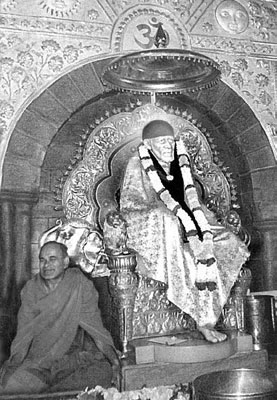Holy Shirdi | SamadhiMandir - The Statue and Tomb of Sri Sai Baba

Cherished statue of Sri Sai Baba
For pilgrims to Shirdi, darshan at Baba's tomb is the climax of their visit and the statue above the tomb represents the living, breathing God. As such, it is the focus of all their longings, hopes and desires, and a concrete form to which they can express their love. The statue is admired as an extraordinary andexquisite image, exuding grace and benevolence, and a mysterious vitality. Baba sits relaxed, natural and majestic, gazing benignly on the millions of diverse visitors who flock to him for succour. Many have commented on the life-like quality of the eyes, as these are typically the most difficult feature to portray in a stone sculpture. In this statue, though, they really do seem to be looking at us and responding!
Baba repeatedly assured devotees that he would never cease to answer their call even from his tomb, and that his mission is "to give blessings". The pull of the tomb, above which the statue sits, is powerful and intense and draws seekers to Shirdi in numbers that increase every year. Here, devotees address their heartfelt prayers, beg for help, give thanks and offerings for prayers answered and wishes fulfilled, sing their devotion, and pay humble obeisance to their beloved deity. For them, the statue does not merely represent God, it is God; and the opportunity to prostrate before it and make oblations may be the fulfilment of a lifetime's ambition.
The statue, which has become such a famous and well-loved image of Baba, was not installed until 1954, and there is an intriguing story behind it. Some white marble arrived from Italy at the Bombay docks, but nobody seemed to know anything about it - who it was for, or why it had come. In the absence of a claimant, the dockyard auctioned it and the purchaser offered it to the Shirdi Sansthan (temple authorities). Impressed by the quality of the marble, they wanted to use it for an image of Baba and gave the commission to a sculptor from Bombay, Balaji Vasant Talim. However, the latter had only one black-and-white photo of Baba to use as his model and was struggling to get the likeness. One night Baba came to him in a dream, remarked on his difficulties and then showed him his face from various angles, encouraging Talim to study it thoroughly and remember it well. This gave Talim the fillip he needed and after that the work flowed easily and the result exceeded all expectations.
Baba's darshan
The statue was installed on 7 October 1954, on Vijayadasami day, the 36th anniversary of Baba's mahasamadhi. The ceremony was performed by Swami Sai Sharananand who, as a youth (then named Vaman Patel), had had direct contact with Baba during the eight years before Baba's mahasamadhi. The Nandi bull (statue of Shiva's vehicle) now seen at the entrance of the temple was added later. The silver throne upon which the statue is seated and from where Baba governs his spiritual empire weighs 60.82 kg. A grand new throne weighing 205 kg was installed on Ramanavami 2002 and is used on special festival days.
Baba's tomb with padukas in front.
"My bones will assure you from my samadhi.
It will communicate with you.
It will respond to whoever surrenders to it."
"My bones will assure you from my samadhi.
It will communicate with you.
It will respond to whoever surrenders to it."
As the main object of adoration in Shirdi, the statue is accorded all due honours. As one of the chief Sansthan officials said, "We believe that Baba is still alive." Out of their love for Baba, devotees wish to provide every comfort and respect they can. Accordingly, Baba is given a hot water bath in the morning, offered breakfast, lunch and dinner, has his clothes changed four times a day before each arati and is adorned with a silver or gold crown for the arati worship. At night a mosquito net is hung and the tomb is spread with a special plain white cotton cloth, of the type that Baba's kafni was made. A glass of water is kept by his side. Each morning at five o'clock Baba is woken up, the mosquito net is removed, and incense is offered while bhupali (a morning raga) is sung
Devotees queue for darshan inside the Samadhi Mandir
Believing that their work is service to a living Sai Baba, a living god, the priests carry out their duties with tender love and care. One of them related that once when bathing the statue, he inadvertently dropped the water container onto it.
For the next two days he had a severe pain in his knee, went to the doctor, had injections, took painkillers and did everything he could to try to alleviate it. Eventually he prayed to Baba and asked why he had to suffer in this way. That night Baba came to him in a dream and said, "You think you're in pain, but how do you think I felt when you dropped the jar?" Thereafter the priest was careful not to injure Baba in any way, and to respect the statue as if it were the living Baba in a physical body.
The feeling and experience that Baba is still alive and present pervades all the Sansthan facilities and activities of his devotees. As you move around Shirdi, you will see that this sentiment informs life, worship and pilgrimage here and contributes to the mystique and magic of what we call Shirdi.
(Source : https://holyshirdi.saibaba.com/samadhi-mandir/thestatue-1.html)



